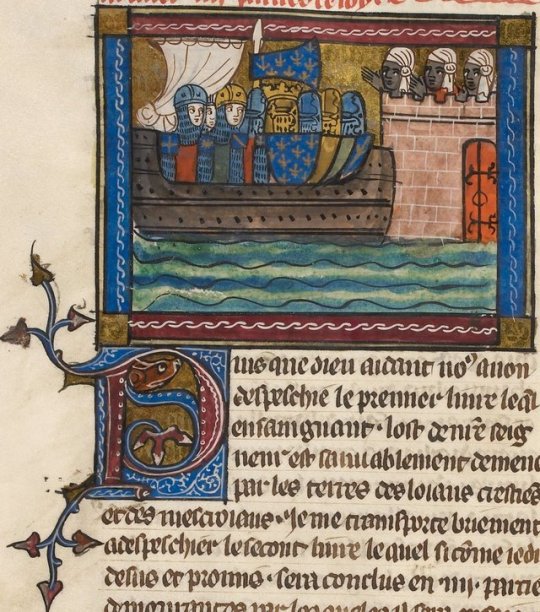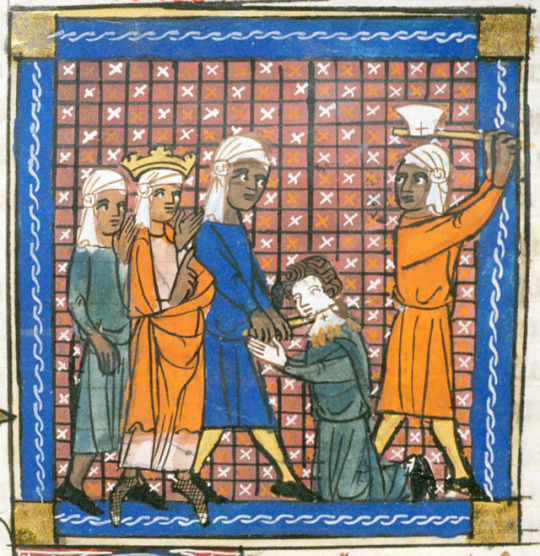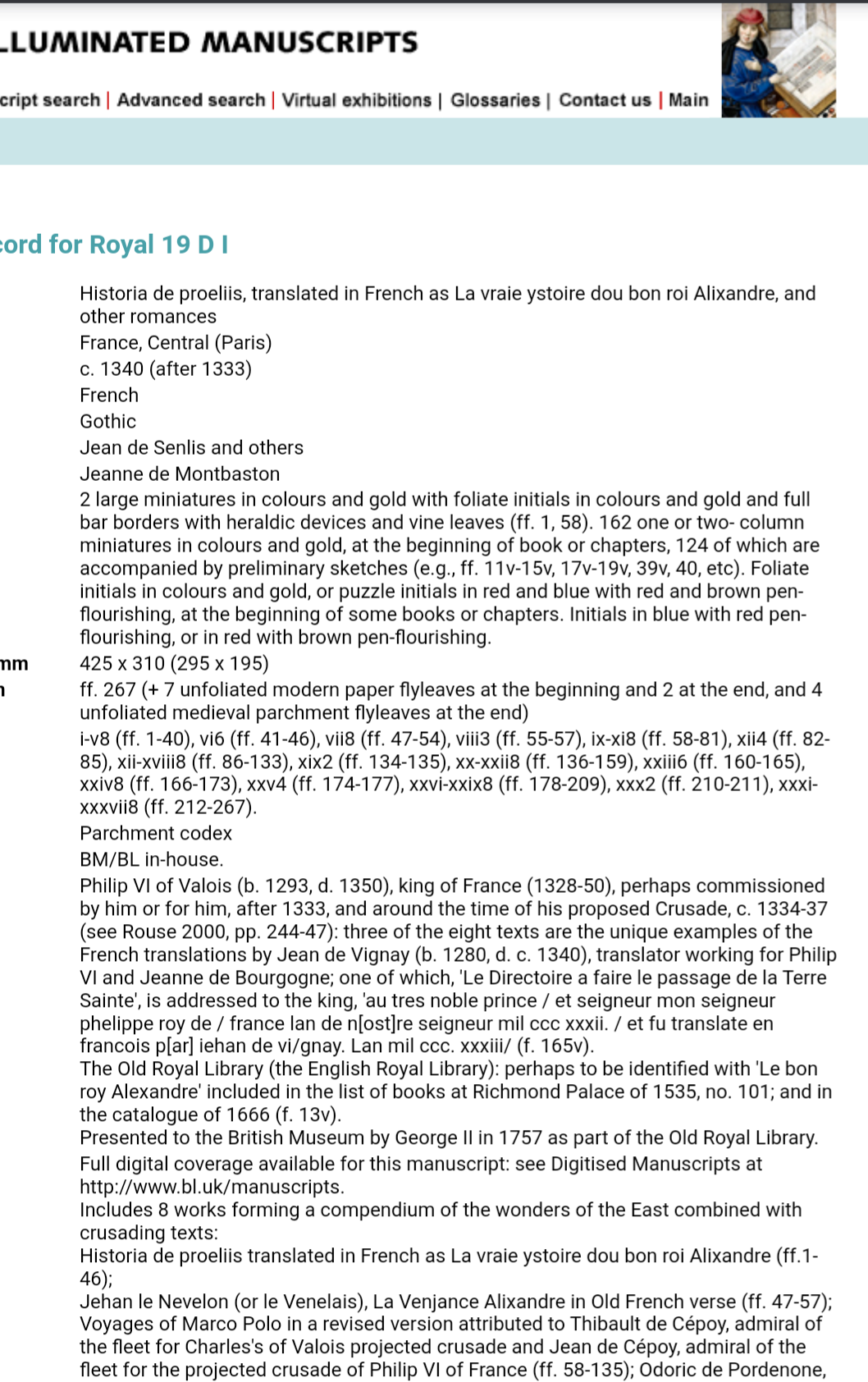It looks like you're using an Ad Blocker.
Please white-list or disable AboveTopSecret.com in your ad-blocking tool.
Thank you.
Some features of ATS will be disabled while you continue to use an ad-blocker.
6
share:
Hi folks I'm looking for help in trying to understand what is taking place in these pieces of art, I can't read much less understand the text, I can
only view what I see before me, don't know if these were meant to be fictional characters or real encounters, some indicate great violence, others,
peaceful dialog??.. The site that I got this from is not much help in this regard.


medievalpoc.tumblr.com...
Go here for more.


All of these images are from the same manuscript, the Historia de Proeliis [Royal 19 D I], illuminated in France by Jeanne de Montbaston in the 14th Century. I’ve shared almost of them in their own in separate posts, but I think it’s also important to show just how many of the total human figures in this lavishly decorated manuscript have dark brown skin.
The people represented here are from all walks of life: knights, “magicians”, kings, everyday people, worshipers, defenders, or representatives of a group.
Jeanne de Montbaston; Historia de Proeliis [Royal 19 D I]
France (1340)
medievalpoc.tumblr.com...
Go here for more.
edit on 1-3-2021 by Spider879 because: Add content
a reply to: Spider879
I don't know if you've seen this British Library Website.
Apart from the initial description, at the bottom of the page, there are thumbnails of the manuscript pages. Clicking each one gives some brief info about what's occurring.
I don't know if you've seen this British Library Website.
Apart from the initial description, at the bottom of the page, there are thumbnails of the manuscript pages. Clicking each one gives some brief info about what's occurring.
originally posted by: Encia22
a reply to: Spider879
I don't know if you've seen this British Library Website.
Apart from the initial description, at the bottom of the page, there are thumbnails of the manuscript pages. Clicking each one gives some brief info about what's occurring.
Much thanks for the link, although I got a 503 maintenance, should be ok later.
edit on 1-3-2021 by Spider879 because: Fix stuff.
Can't help with the translation, but based on manner of dress and some of the context of the art (14th century French origin, depicts ships of knights
sailing towards fortified castles) , to me this looks like it's describing a historical event: the
Crusades.
originally posted by: SleeperHasAwakened
Can't help with the translation, but based on manner of dress and some of the context of the art (14th century French origin, depicts ships of knights sailing towards fortified castles) , to me this looks like it's describing a historical event: the Crusades.
You know that's a good call..
The text is old French and I believe it may depict the outcome of a battle or attempted siege that went badly. Note the crown in the boat is on the
head of one of the executioners in the next. Kings did lead some crusader forces and this may describe how one of them was captured and killed.
It might be Louis IX - en.wikipedia.org...
It may depict his capture and the execution of some of his men.
It might be Louis IX - en.wikipedia.org...
It may depict his capture and the execution of some of his men.
edit on 1-3-2021 by Asktheanimals because: (no reason given)
a reply to: Spider879
Yes, I'm getting the same clicking the link here on ATS (could be a referral problem), but if I right click (long press on cellphone) and select open in new tab it works fine. Otherwise, quote my post to get the link and copy and paste it into a new browser tab.
*Edit: Sorry, it's 503 now whatever method I use. It's a shame because I think it would answer a lot of your questions. As you said, it should be available again, soon.
For the pages that contain text you could try a OCR (Optical Character Recognition) program that can read/interpret medieval text and extract it to our modern language. Then, run the, presumably, French text through Google Translate.
Just search for "ocr reader medieval french text"
for a plethora of programs that could work.
Hope that helps.
Yes, I'm getting the same clicking the link here on ATS (could be a referral problem), but if I right click (long press on cellphone) and select open in new tab it works fine. Otherwise, quote my post to get the link and copy and paste it into a new browser tab.
*Edit: Sorry, it's 503 now whatever method I use. It's a shame because I think it would answer a lot of your questions. As you said, it should be available again, soon.
For the pages that contain text you could try a OCR (Optical Character Recognition) program that can read/interpret medieval text and extract it to our modern language. Then, run the, presumably, French text through Google Translate.
Just search for "ocr reader medieval french text"
for a plethora of programs that could work.
Hope that helps.
edit on 1-3-2021 by Encia22 because: (no reason given)
a reply to: Spider879
The depiction of the people at the castle; could be from Mali, they were a large trade stop during that time.
The fabled Timbuktu stories, is what that reminds me of.
ETA: René Caillié was first French Explorer (and European) to return from Timbuktu alive.
However this was not until the 1820s
Still looks like Western African people to me (from that specific time period)..
Either way, thanks for sharing.... I’ll keep digging
The depiction of the people at the castle; could be from Mali, they were a large trade stop during that time.
The fabled Timbuktu stories, is what that reminds me of.
ETA: René Caillié was first French Explorer (and European) to return from Timbuktu alive.
However this was not until the 1820s
Still looks like Western African people to me (from that specific time period)..
Either way, thanks for sharing.... I’ll keep digging
edit on 1-3-2021 by SeektoUnderstand because: (no reason given)
a reply to: Spider879
Library of Congress link to this manuscript Couldn’t find those pages though
Written by Leo Archipresbyter in the 10th Century.
Translated by Johann Hartlieb in the 1400s
Per the link description
Library of Congress link to this manuscript Couldn’t find those pages though
Written by Leo Archipresbyter in the 10th Century.
Translated by Johann Hartlieb in the 1400s
Per the link description
edit on 1-3-2021 by SeektoUnderstand because: (no reason given)
originally posted by:
The text is old French and I believe it may depict the outcome of a battle or attempted siege that went badly. Note the crown in the boat is on the head of one of the executioners in the next. Kings did lead some crusader forces and this may describe how one of them was captured and killed.
It might be Louis IX - en.wikipedia.org...
It may depict his capture and the execution of some of his men.
Those look like stylized Fleur-de-Lis emblems on the banner.
One of the images on the pintrest page is of 2 armies fighting with 2 kings leading. One of the kings has a sword through his back. It is the 6th
image down.
I can not read old ancient French but i do know that is a depiction of the battle of Prester John and Ghengis Khan. Seeing as to how the story was popular in Europe during the Middle Ages, i would guess the story is of Prester John.
www.bl.uk...
I can not read old ancient French but i do know that is a depiction of the battle of Prester John and Ghengis Khan. Seeing as to how the story was popular in Europe during the Middle Ages, i would guess the story is of Prester John.
www.bl.uk...
a reply to: Spider879
There's more, lots more, at the link.
www.bl.uk...
There's more, lots more, at the link.
www.bl.uk...
Detailed record for Royal 19 D I
Title Historia de proeliis, translated in French as La vraie ystoire dou bon roi Alixandre, and other romances
Origin France, Central (Paris)
Date c. 1340 (after 1333)
Language French
Script Gothic
Scribe Jean de Senlis and others
Artists Jeanne de Montbaston
originally posted by: Iamonlyhuman
a reply to: Spider879
There's more, lots more, at the link.
www.bl.uk...
Detailed record for Royal 19 D I
Title Historia de proeliis, translated in French as La vraie ystoire dou bon roi Alixandre, and other romances
Origin France, Central (Paris)
Date c. 1340 (after 1333)
Language French
Script Gothic
Scribe Jean de Senlis and others
Artists Jeanne de Montbaston
That's weird, when I Duckduckgo "Royal 19 D I" (I refuse to use Google), it's the first link and works perfectly. But I just tried the link in my post and it doesn't work. So, my point is, you may have to search using "Royal 19 D I" as your search.
Here's the address: " //www.bl.uk/catalogues/illuminatedmanu.record.asp?MSID=8467 " (don't use the quotes)
edit on 1/3/2021 by
Iamonlyhuman because: (no reason given)
a reply to: Spider879
I know nothing about art but something about history.
European soldiers on a boat, dark-skinned warriors on city walls.
To me that says "crusaders arriving in the holy Land"
The city could be meant for Acre, which was a port, or Jerusalem, which is nowhere near the sea.
The second scene looks then like the beheading of a European captive.
I now go to look up information about the book, which ought to be an important clue.
It is a book about somebody's wars.
I know nothing about art but something about history.
European soldiers on a boat, dark-skinned warriors on city walls.
To me that says "crusaders arriving in the holy Land"
The city could be meant for Acre, which was a port, or Jerusalem, which is nowhere near the sea.
The second scene looks then like the beheading of a European captive.
I now go to look up information about the book, which ought to be an important clue.
It is a book about somebody's wars.
edit on 1-3-2021 by DISRAELI because: (no reason given)
At first glance, the first one looked like some image of the Crusades to me as well. Not to be 'that guy', but I did a google image search and it
seems to agree with me. (at least on my browser, right click on the image and select search google for image)
edit on 1-3-2021 by
DragonsDemesne because: (no reason given)
As the British Library link I posted keeps coming up 503, even though the page exists, you should find it easily by Googling - "Historia de Proeliis
[Royal 19 D I]".
For some reason the link just doesn't want to work when posted here.
This is what you should see:

For some reason the link just doesn't want to work when posted here.
This is what you should see:

edit on 2-3-2021 by Encia22 because: (no reason given)
The OP's website itself links to The Travels of Marco Polo and the narrative of the Great Khan's siege of a city called Saianafu (Book 2:
chapter 70, translated by Henry Yule around 1871, although that edition was differently illustrated).
en.wikisource.org...
For more on the book (and it's various titles, translations, editions and authorship):
en.wikipedia.org...
Despite serious concerns about the veracity of the narrative, around 1300 some considered the work politically useful:
en.wikipedia.org...
en.wikisource.org...
For more on the book (and it's various titles, translations, editions and authorship):
en.wikipedia.org...
Despite serious concerns about the veracity of the narrative, around 1300 some considered the work politically useful:
Since Dominican fathers had among their missions that of evangelizing foreign peoples (cf. the role of Dominican missionaries in China[22] and in the Indies[23]), it is reasonable to think that they considered Marco's book as a trustworthy piece of information for missions in the East. The diplomatic communications between Pope Innocent IV and Pope Gregory X with the Mongols[24] were probably another reason for this endorsement. At the time, there was open discussion of a possible Christian-Mongul alliance with an anti-Islamic function.[25] In fact, a mongol delegate was solemnly baptised at the Second Council of Lyon. At the Council, Pope Gregory X promulgated a new Crusade to start in 1278 in liaison with the Mongols.[2
en.wikipedia.org...
edit on 2-3-2021 by halfoldman because: (no reason given)
a reply to: Encia22
The implication of that page is that the book is about the wars of Alexander the Great,
In that case, the illustration would be meant to depict the arrival of his Greek army in India.
However, Alexanders army marched by land, instead of going by sea, so I suppose the illustrator's conception of "fighting in the east" has been influenced by he European crusader tradition.
The implication of that page is that the book is about the wars of Alexander the Great,
In that case, the illustration would be meant to depict the arrival of his Greek army in India.
However, Alexanders army marched by land, instead of going by sea, so I suppose the illustrator's conception of "fighting in the east" has been influenced by he European crusader tradition.
new topics
-
Electrical tricks for saving money
Education and Media: 3 hours ago -
VP's Secret Service agent brawls with other agents at Andrews
Mainstream News: 4 hours ago -
Sunak spinning the sickness figures
Other Current Events: 5 hours ago -
Nearly 70% Of Americans Want Talks To End War In Ukraine
Political Issues: 5 hours ago -
Late Night with the Devil - a really good unusual modern horror film.
Movies: 7 hours ago -
Cats Used as Live Bait to Train Ferocious Pitbulls in Illegal NYC Dogfighting
Social Issues and Civil Unrest: 8 hours ago -
The Good News According to Jesus - Episode 1
Religion, Faith, And Theology: 10 hours ago
top topics
-
Cats Used as Live Bait to Train Ferocious Pitbulls in Illegal NYC Dogfighting
Social Issues and Civil Unrest: 8 hours ago, 8 flags -
Florida man's trip overseas ends in shock over $143,000 T-Mobile phone bill
Social Issues and Civil Unrest: 15 hours ago, 8 flags -
VP's Secret Service agent brawls with other agents at Andrews
Mainstream News: 4 hours ago, 8 flags -
Former Labour minister Frank Field dies aged 81
People: 17 hours ago, 4 flags -
HORRIBLE !! Russian Soldier Drinking Own Urine To Survive In Battle
World War Three: 12 hours ago, 3 flags -
Nearly 70% Of Americans Want Talks To End War In Ukraine
Political Issues: 5 hours ago, 3 flags -
Sunak spinning the sickness figures
Other Current Events: 5 hours ago, 3 flags -
Bobiverse
Fantasy & Science Fiction: 15 hours ago, 3 flags -
Electrical tricks for saving money
Education and Media: 3 hours ago, 3 flags -
Late Night with the Devil - a really good unusual modern horror film.
Movies: 7 hours ago, 2 flags
active topics
-
President BIDEN Vows to Make Americans Pay More Federal Taxes in 2025 - Political Suicide.
2024 Elections • 136 • : ImagoDei -
Electrical tricks for saving money
Education and Media • 3 • : Mike72 -
TLDR post about ATS and why I love it and hope we all stay together somewhere
General Chit Chat • 10 • : theshadowknows -
VP's Secret Service agent brawls with other agents at Andrews
Mainstream News • 31 • : WeMustCare -
Why to avoid TikTok
Education and Media • 20 • : 5thHead -
How ageing is" immune deficiency"
Medical Issues & Conspiracies • 32 • : annonentity -
-@TH3WH17ERABB17- -Q- ---TIME TO SHOW THE WORLD--- -Part- --44--
Dissecting Disinformation • 657 • : daskakik -
HORRIBLE !! Russian Soldier Drinking Own Urine To Survive In Battle
World War Three • 30 • : DaRAGE -
Spectrophilia - Women Who Have Had Affairs With Ghosts Say Spooks Are Better Lovers Than Real Men
Paranormal Studies • 32 • : burritocat -
Cats Used as Live Bait to Train Ferocious Pitbulls in Illegal NYC Dogfighting
Social Issues and Civil Unrest • 18 • : Xtrozero
6
